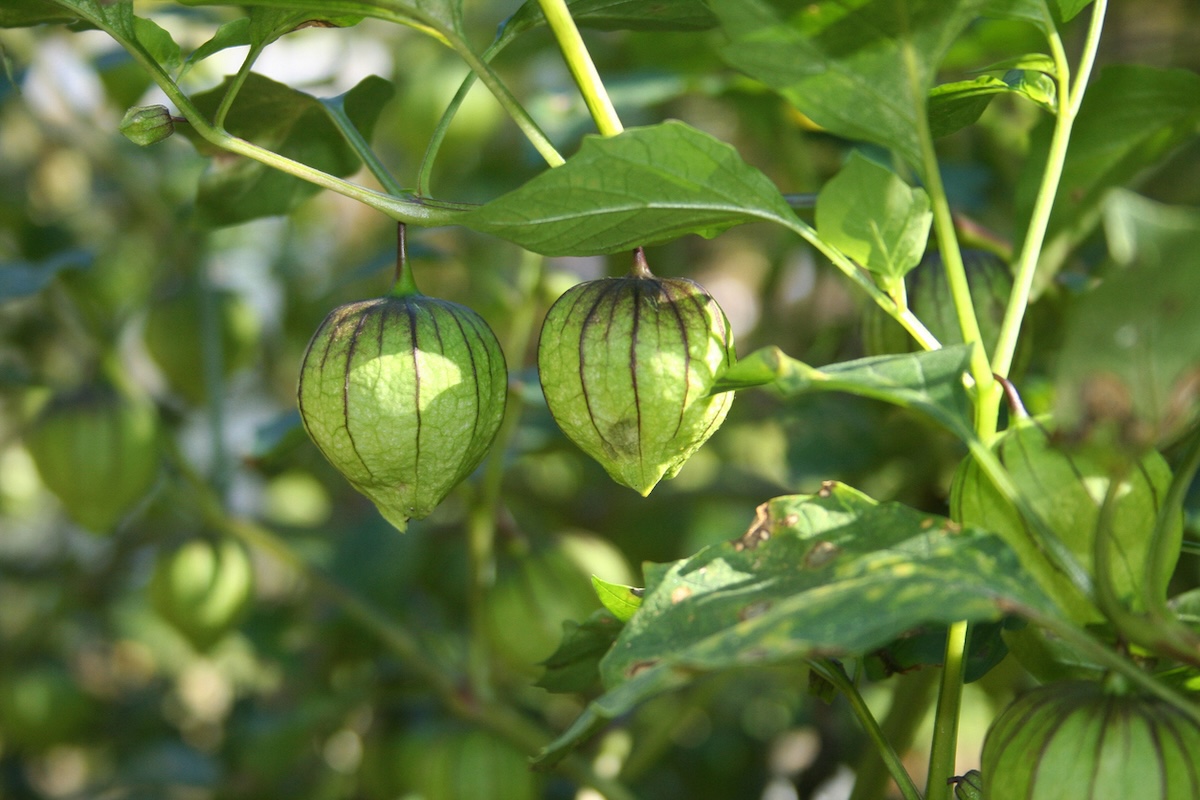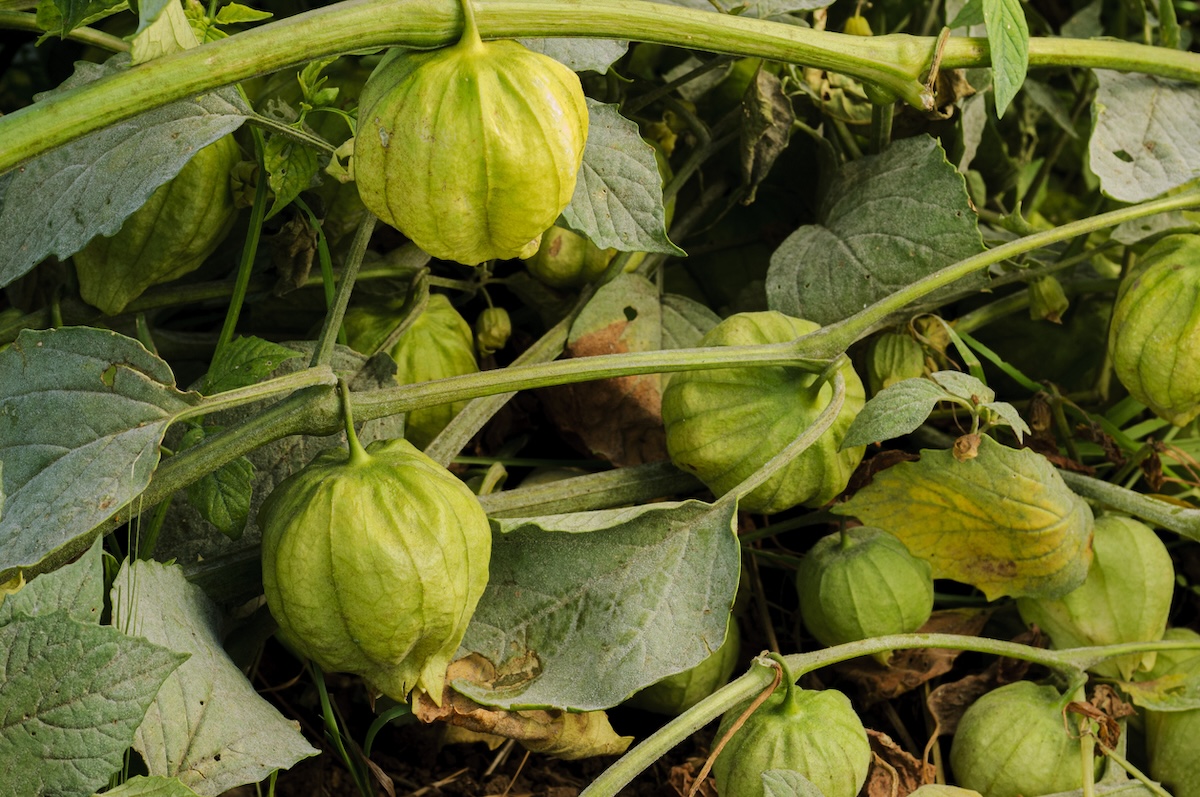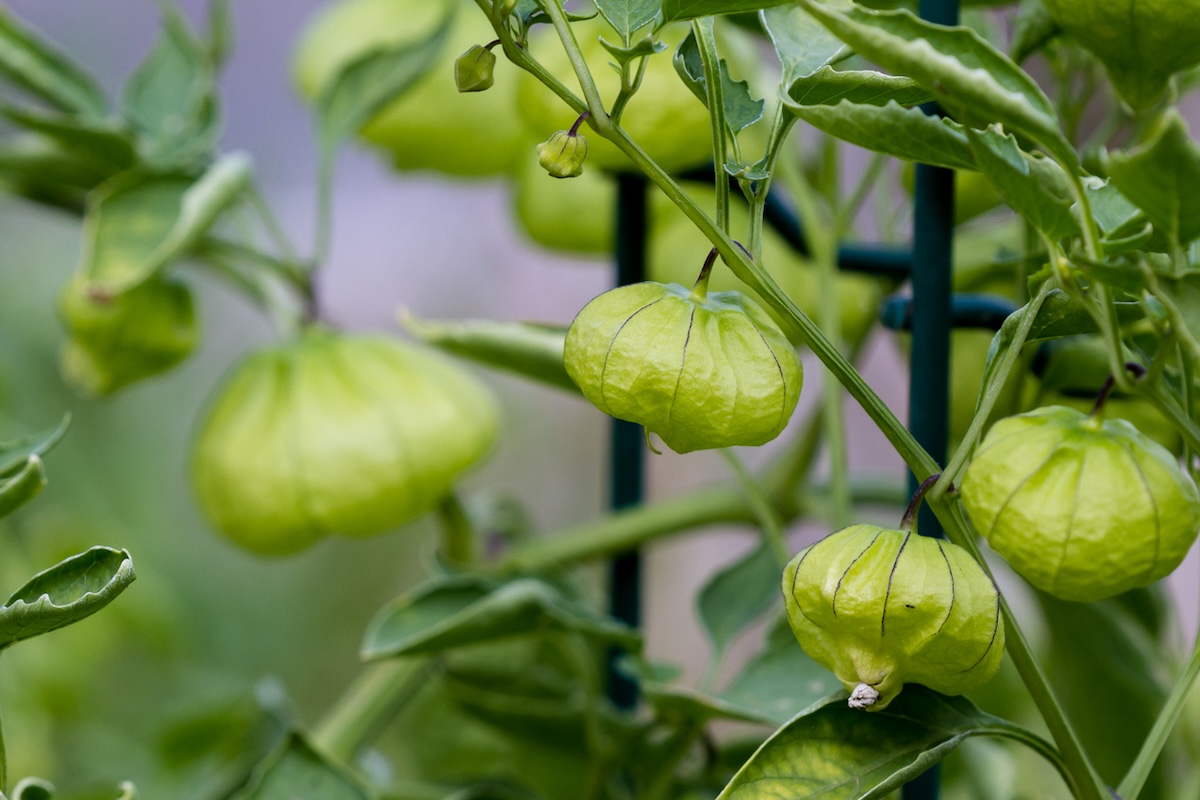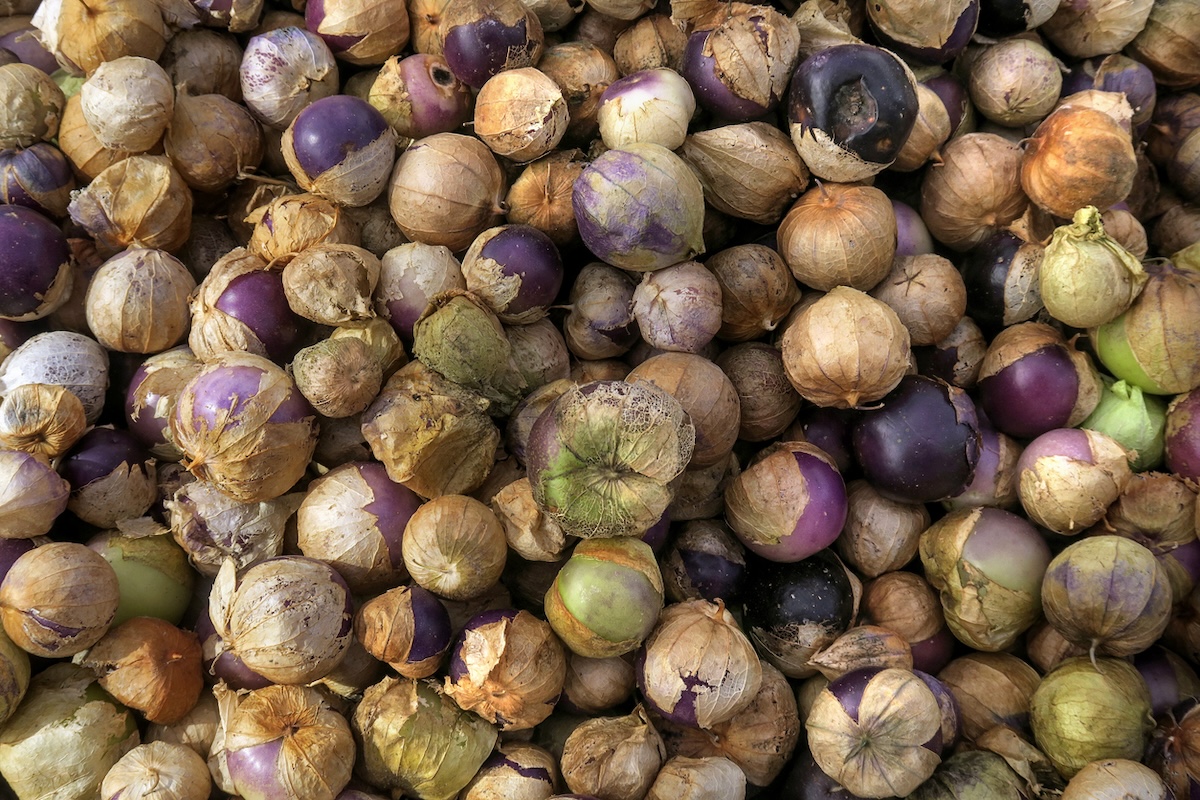

We may earn revenue from the products available on this page and participate in affiliate programs. Learn More ›
Though sometimes mistakenly believed to be types of tomatoes, tomatillos actually derive from an entirely different genus, though they are related to the better known fruits. So, if you know how to grow tomatoes you also should know quite a bit about how to grow tomatillos.
Most widely used in salsa verde, they—according to the Utah State University—”have a tangy, citrus flavor that is slightly acidic.” Keep in mind that you should harvest the most common green types before they yellow, or you may be left with a flatter flavor.
Growing Tomatillos at a Glance
Common Name: Tomatillo, husk tomato, miltomate
Scientific Name: Physalis ixocarpa or Physalis philadelphica
Hardiness Zone: 10-11
Soil: Fertile, well-drained
Light: Full sun
Water: Medium
Food: Organic vegetable and tomato fertilizers
Propagation: Seeds
Safety: Ripe fruits edible, foliage toxic
Tomatillo Characteristics
Native to Mexico and Central America and hardy in USDA Zones 10 and 11, tomatillos are raised as annuals elsewhere. A tomatillo plant typically grows 3 to 4 feet tall, though there are shorter cultivars.
Their yellow blooms generally aren’t much larger than ½-inch across with green or purple blotches at the base of each petal. Those flowers are followed by fruits that may be green, purple-tinged, or yellow and, when fully grown, vary in diameter from ¾ inch to 3 inches. They are enclosed inside papery husks that split once the fruits are ready to be harvested.
Tomatillos can be invasive since they self-sow freely and their sprawling stems root wherever they touch the soil. So, you’ll want to support your plants with stakes or tomato cages to keep them off the ground and gather all the fruits whether you plan to use them or not.
Recommended Tomatillo Varieties
- ‘Purple de Milpa:’ Named for a crop-growing system of the Yucatan, this type makes ¾ to 1-inch green fruits tinged with purple on a plant that grows to 4 feet.
- ‘Tamayo:’ Perhaps named for Mexican artist Rufino Tamayo, this hybrid offers large 2½ to 3 inch fruits on a plant that tops off at 4 feet.
- ‘Toma Verde:’ Possibly a shortened version of the Spanish “green tomato” (tomate verde), this cultivar produces 2-inch-diameter green fruits that aren’t tomatoes but are definitely green on plants that may tower to 5 feet.
Planting Tomatillos

When planting tomatillos, keep in mind that they produce the best harvests when their blooms are cross pollinated, which means you’ll want to plant at least two tomatillo plants.
When is the best time to plant tomatillos?
In cold climates, sow tomatillo seeds indoors 6 to 8 weeks before your last frost date, so you can set them out after that date, once the soil warms to at least 60 degrees Fahrenheit. Alternatively, you can sow them in the garden after that last frost date, but plants which are directly sown generally take about a month longer to produce a harvest than the transplanted ones do.
Where can tomatillos grow?
The best soil for tomatoes, fertile and well-drained, generally will suit tomatillos too, though the latter can tolerate a broader pH range—anywhere from 5.5 to 7.3. Like tomatoes, tomatillos prefer a full sun location. Good tomatillo companion plants include basil, cilantro, and marigold.
How do you plant tomatillos?
Keep tomatillo seedlings started indoors beneath a plant light.
- Sow tomatillos seeds ¼-inch deep in damp and sterile seed starting mix—if starting them indoors—or in the soil of your garden plot.
- Keep their mix or soil damp and preferably at a temperature of 75 to 85 degrees Fahrenheit until the seeds germinate in 5 days to 2 weeks.
- Thin or transplant tomatillo seedlings so that they stand 2 feet apart.
Can you grow tomatillos in containers?
Tomatillos will grow well in containers as long as those containers are large ones that contain at least 5 gallons of soil and are at least 12 inches deep. You will need two or more of those containers positioned near each other to facilitate cross pollination. Alternatively, choose an even larger container and place more than one plant in it.
Watering Tomatillos

Tomatillos should have at least an inch of water per week, but are somewhat drought tolerant, especially so after they have already set fruit. If you need to supplement their rainwater, use drip irrigation to avoid the fungus diseases sometimes caused by wet foliage. Mulch the plants with 3 inches or so of straw, grass clippings, etc., to help keep their soil damp. Be careful that you don’t overwater them as soggy soil can cause root rot.
Fertilizing Tomatillo Plants
Overfertilization of tomatillo can result in large plants with few fruits, so feed your plants only a couple times during the season. Incorporate a balanced organic vegetable fertilizer such as 5-5-5 into the soil when you set them out, following the instructions on the packaging. After the plants begin to bloom, add an organic tomato fertilizer low in nitrogen and higher in phosphorus and potassium such as 3-6-4 to encourage flowering and fruit set.
Pollination
As was mentioned above, you will need at least two tomatillo plants to provide the cross pollination caused by bees or other insects carrying pollen from one plant to the other. They can be two plants of the same cultivar or two different cultivars.
If you want to save seeds from the fruits, use plants of the same open-pollinated cultivar. Otherwise, the plants may cross with each other and produce seeds that won’t come true to either cultivar.
Safety Considerations
According to a North Carolina Cooperative Extension article on growing tomatillos, “All other parts of the plant are poisonous except the ripe fruit.” That includes the papery husks. Therefore, you’ll want to remove those husks and scrub the fruits well before consuming them.
Potential Pests and Diseases
According to Utah State University, tomatillos “rarely suffer from disease or pest damage.” However, they can contract some of the same maladies that plague tomatoes, such as hornworm and blight. You can help avoid such issues by refraining from planting tomatillos where other members of the nightshade family have grown in recent years.
If your plants produce excessive foliage with few fruits, you probably overfertilized them. However, blossoms may drop from the plants before setting fruits during periods of temperature extremes above 90 degrees Fahrenheit or below 55 degrees.
Harvesting Tomatillos

Because the plants are indeterminate, tomatillo season lasts until frost.
When is the best time to harvest tomatillos?
Harvest your tomatillos once they fill the insides of their papery husks and those husks have turned from green to brown and are beginning to break open. Harvest green varieties before they turn yellow and yellow types after they turn yellow. Purple cultivars should be tinged with that hue before you pick them.
How do you harvest tomatillos?
A ripe tomatillo often will fall from the plant.
- When harvesting tomatillos use pruning shears to snip the encased fruits from their plants.
- Alternatively, twist and tug each fruit from the plant; it should come off easily if ripe.
- If you don’t intend to use the fruits right away, leave them inside their husks.
How do you store tomatillos?
After picking tomatillos, you can store the fruits still inside their husks in a paper bag in your refrigerator for 2 to 3 weeks. Alternatively, husk, wash, and freeze them as you would berries. After washing the sticky film from the surface of each fruit, spread those fruits on a cookie sheet to dry before placing them in the freezer. Once they are frozen, pack them into sealable freezer bags and return them to the freezer.
Looking for more unusual fruits and vegetables? Check out our guides on growing artichoke, dragon fruit, and edamame.
